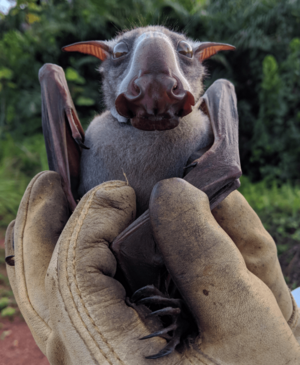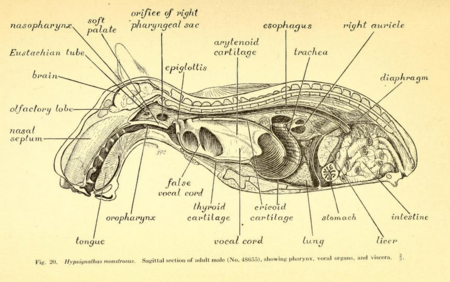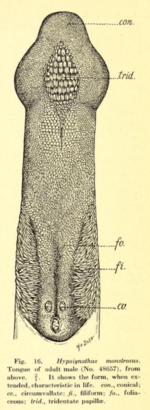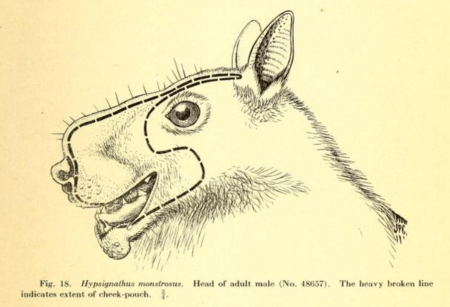Hammer-headed bat facts for kids
Quick facts for kids Hammer-headed bat |
|
|---|---|
 |
|
| Conservation status | |
| Scientific classification | |
| Genus: |
Hypsignathus
|
| Species: |
monstrosus
|
 |
|
| Hammer-headed bat range | |
| Synonyms | |
|
|
The hammer-headed bat (Hypsignathus monstrosus), also known as the hammer-headed fruit bat, is a type of megabat found across West and Central Africa. It's the only member of its group, Hypsignathus. This bat is the largest in mainland Africa, with wings that can spread almost 1 m (3.3 ft) wide.
Male hammer-headed bats are nearly twice as heavy as females. They also look very different, making them the most sexually dimorphic (meaning males and females look very different) bat species in the world. Males have huge larynges (voice boxes) and special chambers in their faces. These help them make very loud honking sounds. Females, on the other hand, have more typical fox-like faces.
Hammer-headed bats mainly eat fruit like figs, bananas, and mangoes. They search for food at night and sleep in trees during the day. Unlike many other bats, males and females often roost (sleep) together. They have two mating seasons each year. Males gather in special areas called "leks" to attract females with their loud calls. Females choose a male to mate with, and usually one baby bat is born five or six months later.
This bat is sometimes seen as a pest because it eats fruit crops and makes loud noises. In some parts of Africa, people hunt and eat it. Scientists have also studied it to see if it carries the Ebola virus. However, the hammer-headed bat is not considered an endangered species because it lives in a large area and has many members.
Contents
What's in a Name?
The hammer-headed bat was first described in 1861 by an American scientist named Harrison Allen. He gave it the new genus name Hypsignathus. This name comes from ancient Greek words: húpsos, meaning "high," and gnáthos, meaning "jaw." It likely refers to the bat's deeply arched mouth. The species name, monstrosus, is Latin for "having the qualities of a monster." This name probably comes from the bat's unusual appearance, especially the male's large, boxy head.
Appearance
The hammer-headed bat is the biggest bat in mainland Africa. Its wings can spread up to 90.1 cm (2.96 ft) wide. Males are much heavier than females, weighing about 420 g (15 oz) on average, while females weigh around 234 g (8.3 oz).
The biggest difference between males and females is their heads. Males have large, boxy heads with huge lips. Their larynges (voice boxes) are about three times bigger than a female's. These huge voice boxes take up most of the space in their chest, even pushing other organs like the heart and lungs around! Males also have special air sacs in their snouts that act like speakers, making their calls even louder. Females have narrower snouts and look more like typical bats with fox-like faces.
Both male and female bats have dark brown fur. They have white patches of fur near their ears, though these can sometimes be hard to see. Their fur is long and smooth. They have triangular, dark brown ears and very large eyes. Their tongues are big and strong, with a special tip that helps them squeeze juice from fruits.
Their wings are blackish-brown. They have a low "aspect ratio," which means their wings are wide but not very long. This makes them good for carrying heavy loads, like a large body. Hammer-headed bats do not have a tail.
Another interesting fact is how their chromosomes are set up. Usually, females have two X chromosomes and males have one X and one Y chromosome. But male hammer-headed bats have only one X chromosome and no Y chromosome! So, females have 36 chromosomes, and males have 35.
Life and Habits
Diet and Foraging
Hammer-headed bats are frugivores, meaning they eat mostly fruit. They love figs, but also enjoy mangoes, bananas, and guavas. Eating only fruit can mean they don't get enough protein. Scientists think fruit bats have longer intestines to help them get more nutrients from their food.
Males and females find food differently. Females often follow the same routes to find reliable food sources, even if the fruit isn't the best quality. Males, however, travel further, sometimes up to 10 km (6.2 mi), to find the best fruit patches. When they find fruit, they might eat it right there or carry it to another spot. They chew the fruit, swallow the juice and soft parts, and spit out the rest. Because their droppings often contain seeds, they help spread seeds for new plants to grow.
Reproduction and Life Cycle
Not much is known about how hammer-headed bats reproduce. In some areas, they breed twice a year during the dry seasons. The first breeding season is usually from June to August, and the second is from December to February. Females can get pregnant up to twice a year. After five or six months, they usually give birth to one baby, though twins have been seen. Newborns weigh about 40 g (1.4 oz).
Females mature faster than males. They can start having babies at six months old and reach their full size by nine months. Males, however, don't become sexually mature until they are about eighteen months old. For their first year, males and females are similar in size.
This species is famous for its unique mating system called "lek mating." In this system:
- Males gather in a special area, called a "lek," and set up their own small "display territories."
- These territories don't offer anything special to females, just access to the males.
- Females choose which male they want to mate with. All mating happens at the lek.
- Males do not help raise the babies.
During mating season, males form these leks along streams or riverbeds. A lek can have 20 to 135 males spread out over an area up to 1,600 m (5,200 ft) long. Each male claims a small spot, about 10 m (33 ft) wide, where he hangs from a branch, honking loudly and flapping his wings. They can honk 60 to 120 times per minute! Males display for about four hours, mostly in the early evening and before dawn.
Females fly through the lek and choose a male by landing next to him. The chosen male makes a special "staccato buzz" call, and then they mate for about 30 to 60 seconds. After mating, the female leaves, and the male goes back to calling. The males in the middle of the lek are the most successful. A small group of males (about 6%) are responsible for most of the matings (79%).
However, some hammer-headed bat groups in West Africa do not use leks. Instead, they live in a harem system, where one male mates with several females.
Behavior
During the day, hammer-headed bats sleep in trees, usually 20–30 m (66–98 ft) high in the forest canopy. They don't stick to one roosting spot for long, moving to a new tree every 5 to 9 days. They use their dark fur to blend in with the trees and hide from predators.
These bats can be found alone or in small groups of about four individuals. Sometimes, groups of up to twenty-five bats have been seen. Unlike many other bat species, males and females often roost together. When in a group, they usually stay about 10–15 cm (3.9–5.9 in) apart. Males tend to be on the outside of the group, with females closer to the center. During the day, they mostly sleep with their noses covered by their wings. They don't interact much with each other while roosting. At sunset, they groom themselves and then fly off alone to find food.
Predators and Parasites
We don't know much about what animals hunt hammer-headed bats, but birds like the long-tailed hawk might be predators. These bats can have many parasites, both on their bodies (like bat flies and mites) and inside them (like liver parasites). Adult bats often carry these parasites.
Where They Live
The hammer-headed bat lives in low-lying areas, usually below 1,800 m (5,900 ft) above sea level. They mostly live in rainforests, including swamp forests and forests along rivers. They have a wide range across West and Central Africa. You can find them in countries like Angola, Cameroon, Ghana, Nigeria, and Uganda, among many others.
Interactions with People
As Pests and Food
Because hammer-headed bats eat fruit, they are sometimes seen as pests by farmers. Their extremely loud honking noises at night also make some people consider them a nuisance. In countries like Nigeria and the Democratic Republic of the Congo, these large bats are hunted and eaten as bushmeat.
Disease Studies
Scientists have studied the hammer-headed bat to see if it might carry the Ebola virus. Some bats have shown signs of having antibodies against the virus, meaning they've been exposed to it, even if the virus itself wasn't found. However, as of 2019, the exact animals that carry the Ebola virus in nature are still not fully known.
Conservation Status
As of 2016, the hammer-headed bat is listed as a least-concern species by the IUCN. This means it's not a high priority for conservation. It has a large geographic range, a presumably large population, and its numbers are not thought to be dropping quickly.
Hammer-headed bats are not commonly kept in zoos. They can get stressed easily in captivity, especially when they are moved to new places.






